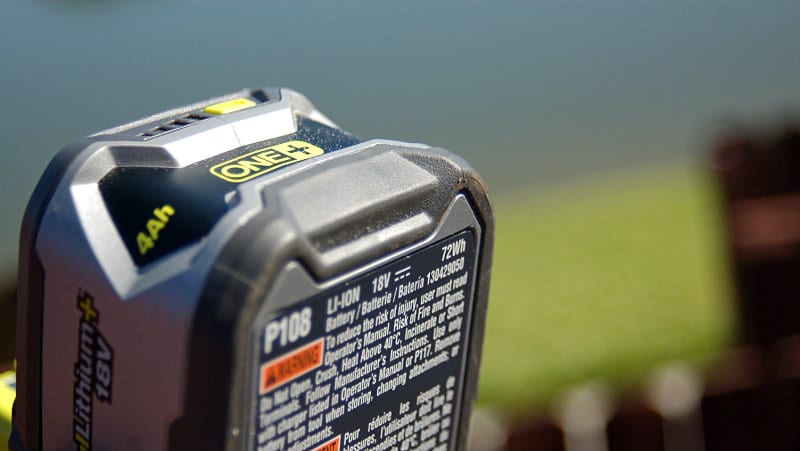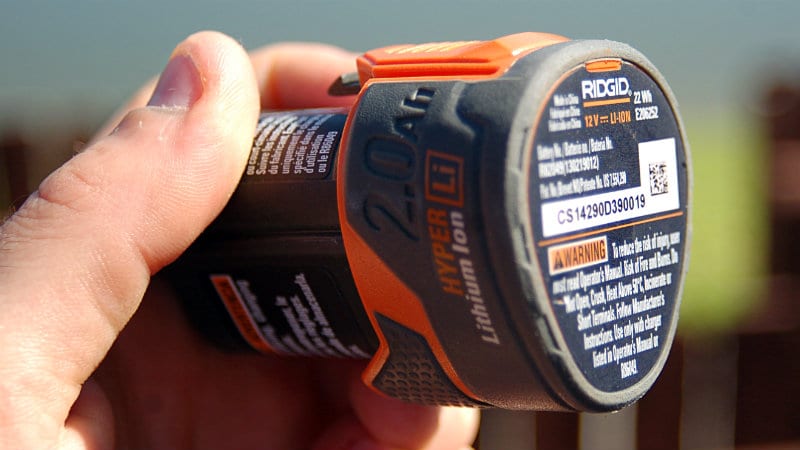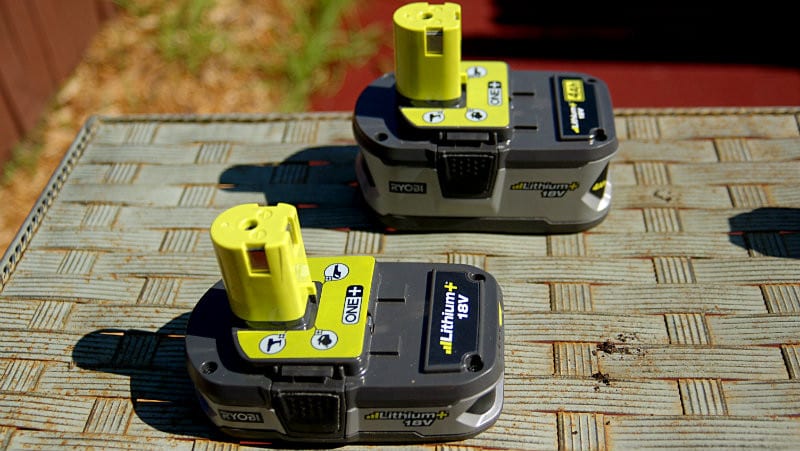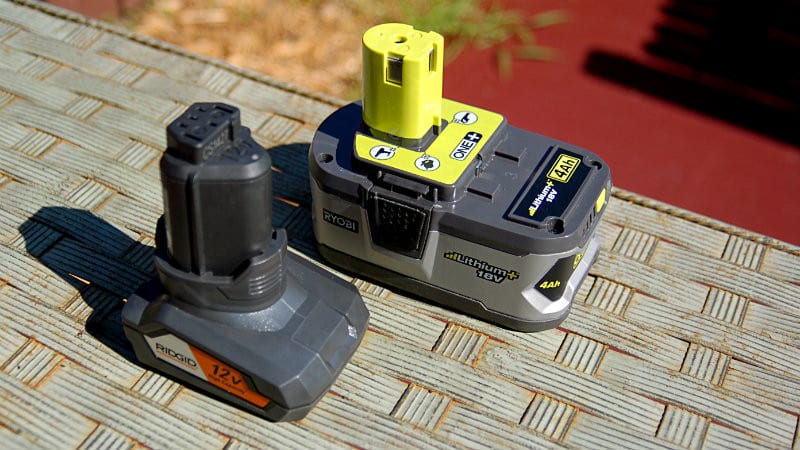Maybe you just want to know more or see if your notions about voltage vs. amp hours are right. Maybe you’re brand new to cordless tools and don’t know where to start. Glad you could make it to the party!
Voltage vs. amp hours is one of the most basic questions asked of cordless tools. It can be confusing. With corded tools, we often describe the amount of power based on the number of amps that it draws. This is great when there’s a virtually infinite power supply. Most people boil cordless tool numbers down to the idea that voltage is equivalent to power and amp hours are equivalent to run time. Yeah… well, sort of… maybe. These two measurements are born of the actual battery capacity—a term known as watt-hours. Here’s the equation:
Amp Hours x Nominal Voltage = Watt Hours
If you look on the label for most batteries, it will tell you the total watt-hours of its capacity. Basically, the larger the fuel tank (watt-hours), the higher the energy potential you have – it’s just a matter of how you use it.
Voltage vs Amp Hours: Wiring to Increase Voltage
If you were to take apart your battery (please don’t do that!) you would find the individual battery cells that store and deliver power to the tool. Each battery is capable of delivering a specific amount of voltage, typically 3.6 volts in the 18650 lithium-ion cells that are used. Need a 12V battery? String 3 of them together in a series. Need an 18V battery? Use 5.
If you’re doing the math along with me, you already know that there’s an issue. The voltage varies slightly within the cells based on the amount of charge that they hold. They can produce a higher voltage at a full charge state than low. That 3.6V cell actually produces a little more than 4V at a full charge state. Even with that, the math doesn’t work out perfectly. Don’t lose faith in me yet, though. I’ll explain those anomalies in a later article. For now, let’s focus on the voltage as power.
If you want more power, simply add another cell in series to the battery. You’ll increase by roughly 4V for each new one you add. In theory, you could do a 12V, 16V, 20V, 24V and so on. Fortunately, the tool industry has settled into 12V, 18V/20V, and 36V platforms for tools while other combinations are out there for outdoor power equipment.
Voltage vs. Amp Hours: Wiring to Increase Amp Hours
A simple definition of amp hours would be the amount of amperage that the battery pack can deliver for one hour. All other factors ignored (like temperature and vibration), a 3.0 amp hour battery will give you 3 amps of current for an hour. A 5.0 amp hour battery will give you 5 amps for an hour. Unlike voltage, this is not a fixed figure. You can draw a higher amperage from a battery and get less run time. Jon Bucklew did an outstanding demonstration of this with the Makita 18V LXT Brushless Angle Grinder. You can also draw fewer amps and run longer.
It’s all linear. Run 2.5 amps on a 5.0 amp hour battery – you get 2 hours of run time. Draw 6 amps on a 3 amp hour battery – now you only get 30 minutes. Here’s a chart that shows how the current draw affects run time.
So how do we get those numbers? Most lithium-ion battery cells are running somewhere around 2000 milliamp hours, or 2.0 amp hours. When you string those cells together in series, they still only produce a combined 2.0 amp hours. In a series, it’s the voltage that gets combined, not the amp hours.
When it’s time to increase the amp hours, you string your cells together in parallel. Here’s an example from a typical 12V battery.
Three 18650 lithium-ion cells are attached in series.
Each cell carries 3.6 volts and 2.0 amp hours. Since they’re in a series, we get 10.8 volts (or 12V when fully charged), but still just the 2.0 amp hours.
A different electronic device takes the same three cells but wires them in parallel. Now they’re producing just 3.6 volts, but 6.0 amp hours.
Voltage vs Amp Hours: Working Together
What happens in high-capacity batteries is a combination of series and parallel wiring. First, you take 5 cells wired in a series to get the 18V you need. Then, parallel another set wired the same way to it. We’ve kept the voltage at 18, but doubled the amp hours to 4.0. In theory, we could add another set to get 6.0 amp-hours at 18V.
In a recent best lawn mower article, we noted that it looked like Black & Decker and Craftsman were basically using repurposed 20V max batteries. They probably were. Take that 20V max, 5.0 amp hour battery in a 5S2P configuration (5 series, 2 parallel = 10 total cells arranged as 2 sets of 5) and make them all work in series. Now you have a 40V max, 2.5 amp hour battery by only changing the configuration to 10S (10 series).
10 total cells arranged in 2 rows of 5 cells in series = 20V Max 5Ah battery pack
10 total cells arranged in 1 continuous row of 10 cells in series = 40V Max 2.5Ah battery pack
Now coming back to the idea of total watt-hours… No matter how you wire the battery cells together the number of cells determines the watt-hours of the pack. Both the 40V (36V nominal), 2.5 amp hour Black & Decker battery and its 20V (18V nominal), 5.0 amp hour cousin have a total of 90 watt-hours.
How Real-World Conditions Affect Run-time
In the real world, things start to get crazy. When you talk about temperature (both too hot and too cold), vibration, and other environmental conditions, the voltage and amp hours start to get away from ideal. Those conditions are part of life on the jobsite, though. In some ways, manufacturers set better expectations by simply listing a lower rating that is more representative of the real work experience (18V nominal instead of 20V Max).
There are ways to make better batteries. You can start playing with the chemistry inside the battery (anodes, cathodes, and electrolytes among other components). Differences occur in each cell’s resistance, impedance, and other fun words that most normal people can’t define. This results in better (or sometimes worse) performance. Suddenly, the same number of cells that produced 18 volts and three amp hours is delivering the same voltage but with 4 amp hours and now 5!
Conclusions
The differences in performance from one company to the next have a lot to do with the battery cells that they use. The electronic controls and safeties that they use also come into play. It’s simply changing the wiring configuration that allows you to add more power to a battery pack, more amp hours, or both. The real-world result of the combination can be simplified to say that higher voltage means more overall power and higher amp hours results in more overall run time.
With manufacturers constantly testing different battery cells and housing designs, we’ll continue to see improvements in the amp hour end of the watt-hour equation. For now, it seems that we’ll continue to see the cordless tool voltage remain where it is while OPE works to settle into a sweet spot.








